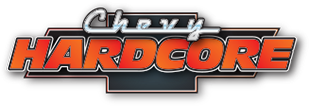For a division that had 33 percent of the entire U.S. car market in the early 1960s, Chevrolet was definitely caught napping in 1962. First, Ford introduced the Fairlane in fall of ’61, creating the midsize car market for which Chevrolet had no competitor. A little over two years later came the Mustang. Chevy executives knew about its development, but felt there was no cause for concern because they had the sporty Corvair Monza.
Ford owned the midsize car market for two years. Yes, GM had the Olds F85, Buick Skylark and Pontiac Tempest, but they were really senior compacts, and Dodge and Plymouth had cars that would fit in this category, but were plagued by styling that was considered odd at best. Chevrolet dealers had an empty space on the showroom floor until 1964, when the Chevelle came to the rescue.

A set of 17-inch Foose rims and bright red paint make this Chevelle Malibu SS perfect. (Photo by Jim Campisano)
The Chevelle Malibu Super Sport was there for midsize customers who wanted something more than ordinary transportation, but then Pontiac unleashed the GTO and suddenly the shiny new Chevelle was a bit of an afterthought in the car world. Yes, the aforementioned SS looked good, but it was just an appearance and trim package. The standard SS engine was a 194 cubic-inch six-cylinder that made a paltry 120 gross horsepower.
Things looked better for 1965, and not just because of the model year facelift. A 300-horsepower 327 became available, as did the now-legendary 350-horse L79 327 (6,021 produced), but thanks to the GTO, big displacement engines were what the specialty car market was looking for.
Chevrolet gave its customer the fabled 396 with 375 horsepower on a limited basis in ’65, which got everyone’s attention, and whet their appetite for 1966.
Simple and clean is the best way to describe the ’65 Chevelle's styling. (Photos by Jim Campisano)
Better Late Than Never
Despite being late to the party, the Chevelle was a smashing success, and by the end of the decade would be selling in the hundreds of thousands every year. Today, the ’64 and ’65 Chevelle are favorably looked upon by enthusiasts. They have clean lines, are practical, and the engine bay can hold any type of powerplant you want.
One such enthusiast is Florida’s Joe Pepe. He purchased this ’65 Malibu SS in 2013. The body and paint had been done (including the color swap from yellow to red), but that was about it. The engine was a sickly 400-inch truck mill that was not in good shape, and it lived where a 283 was born. Joe had his work cut out for him.
Summit Racing crate 350 makes 330 horsepower, which is more than enough for owner Joe Pepe. (Photos by Jim Campisano)
The body was complete. When I bought it, I swapped out the engine, transmission, brakes, and suspension,” Joe said. “I added air conditioning and had the vents and AC system molded into the dashboard.
He added, “It’s my first classic car and the entry point, price-wise, was good. And I like the square body style. I dig the square look.”
For power, he turned to the Summit Racing catalog and picked up a 330-horsepower crate 350. Today, it wears an Edelbrock intake and carburetor, and Hedman shorty-style exhaust headers breathing into a Magnaflow exhaust system. (The long tubes he originally used dragged a lot over bumps.)
The factory is Powerglide long gone, replaced with a 700R4 overdrive, which sends the 350’s power to a 3.73 Posi rear.
21st Century Suspension Tuning
The Chevelle had good bones from the jump, and Joe just improved on what the factory offered. Tubular front control arms and a coilover suspension from Classic Performance Products (CPP) ensure that the A-body goes down the road straight and true but doesn’t collapse when the roads get twisty. Foose 17×9-inch wheels wear Cooper radials (255/50s out back and 225/50s up front) and help the Malibu stick to the road.
(Photos by Jim Campisano)
Braking is enhanced by CPP 12-inch power disc brakes all around with drilled and slotted rotors. The car came with four-wheel drums from Chevrolet, so the difference is profoundly better. We love the look and the stance. It’s not too low, nor are the wheels too large. We think the 17s are a nice compromise on the midsize Chevelle, which is actually a fairly big automobile.
The cockpit has been upgraded with gauges from Dakota Digital, the aforementioned custom dash panel, an ididit tilt column and an aftermarket steering wheel, but the original white interior still needs to be redone. A new top is also in the cards at some point, but it’s usually down, so its condition is a mystery to most.
The original white interior and console could use a little refinishing, but we did the custom air conditioning housing and vents. These were done in Southern California; unfortunately, the owner can't recall the shop's name. (Photos by Jim Campisano)
“If I really wanted to go crazy — and I’m not sure I’d do this — I’d put a new chassis under it, but I don’t think I’ll do that,” said Joe. “The main goal was to make it turn, make it stop, make it so I could drive it when I wanted to. Even the steering, with the big factory wheel, you need to make a bunch of revolutions on it to make a good turn.
(Photos by Jim Campisano)
What’s next? He’s contemplating EFI, but he likes the vintage feel and smells of a carbureted vehicle.
So, yes, while Chevrolet was late to the midsize car market, it certainly did it right when it did, making millions of dollars in profits along the way.
































